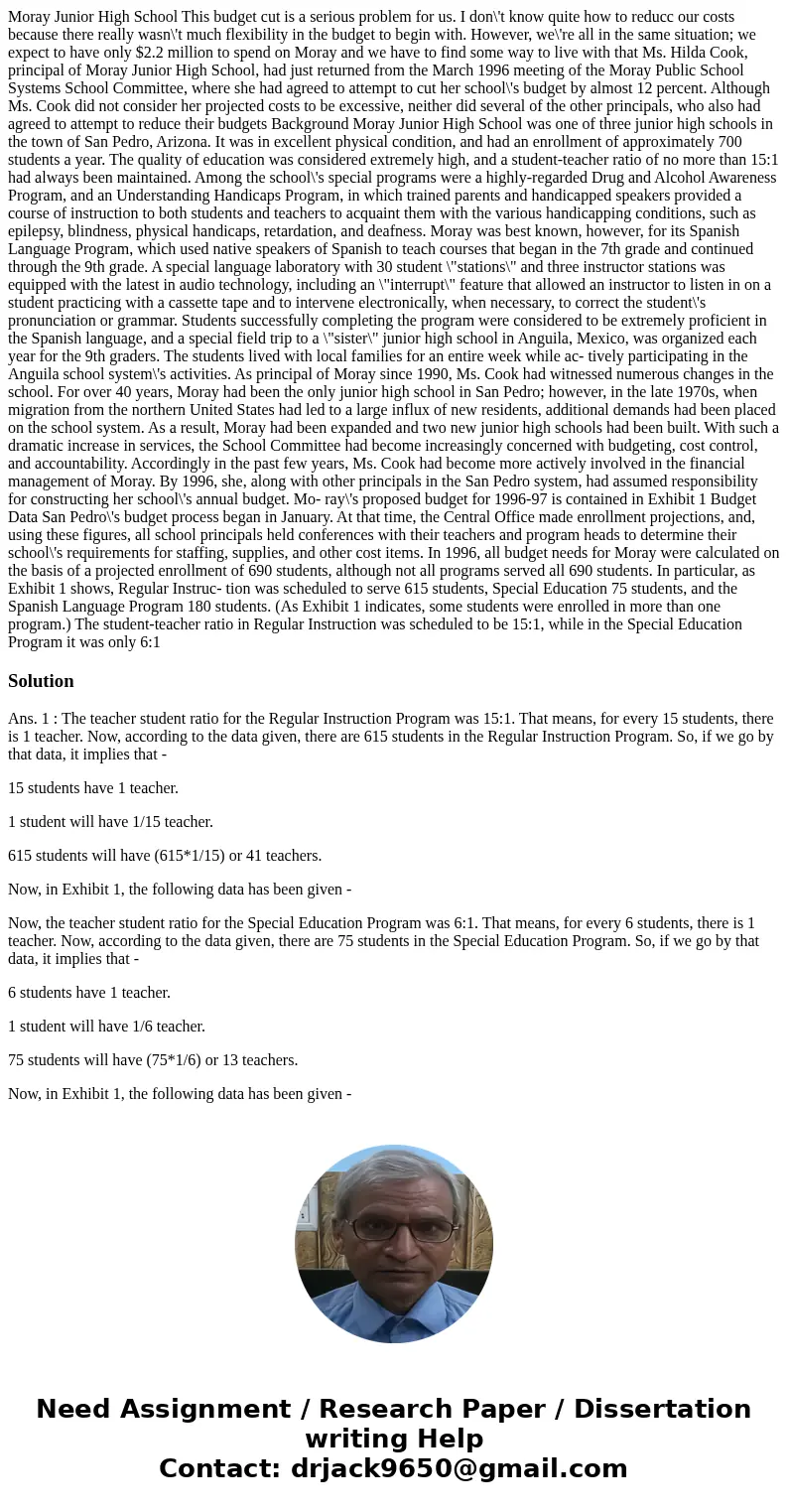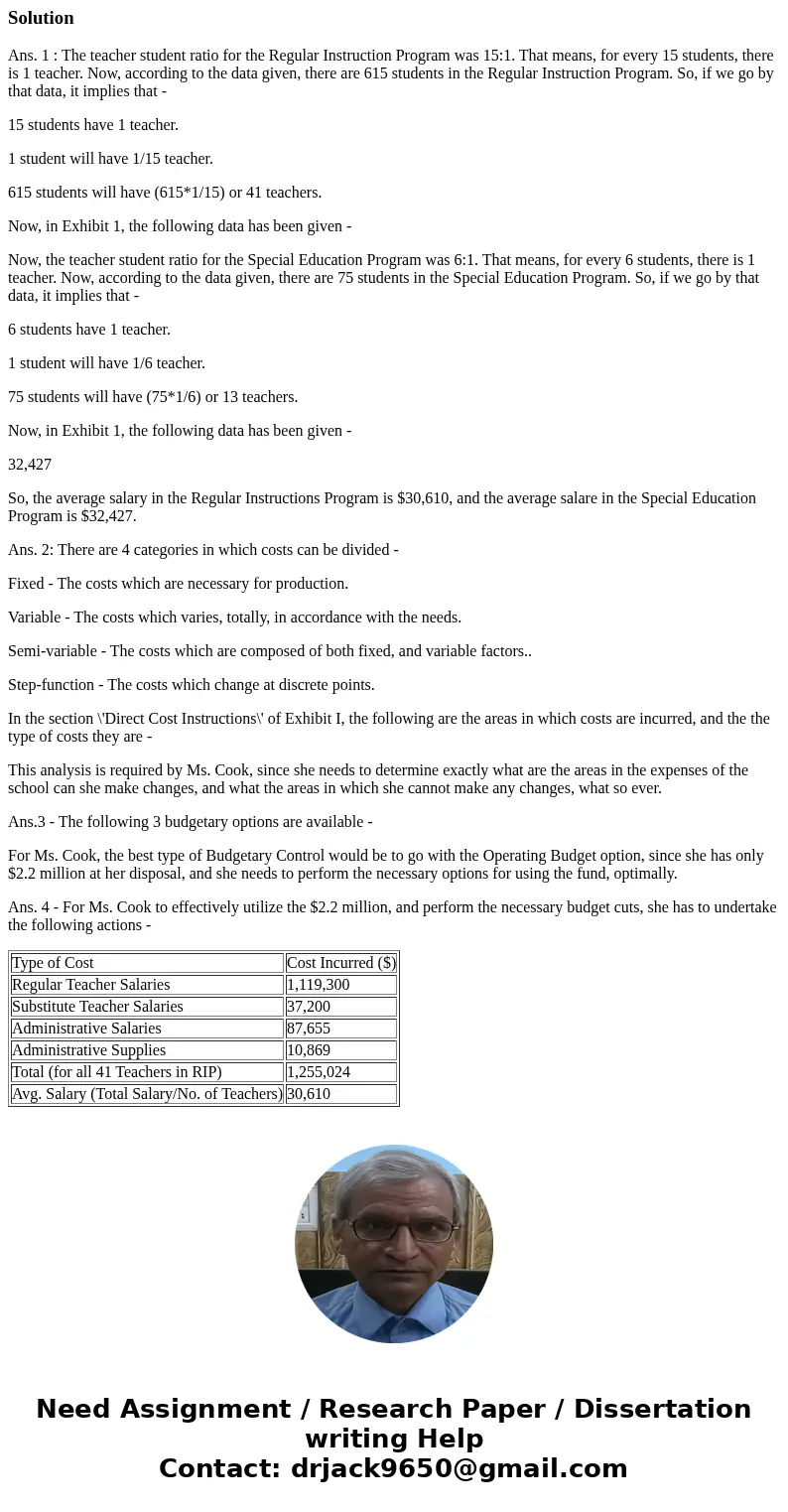Moray Junior High School This budget cut is a serious problem for us. I don\'t know quite how to reducc our costs because there really wasn\'t much flexibility in the budget to begin with. However, we\'re all in the same situation; we expect to have only $2.2 million to spend on Moray and we have to find some way to live with that Ms. Hilda Cook, principal of Moray Junior High School, had just returned from the March 1996 meeting of the Moray Public School Systems School Committee, where she had agreed to attempt to cut her school\'s budget by almost 12 percent. Although Ms. Cook did not consider her projected costs to be excessive, neither did several of the other principals, who also had agreed to attempt to reduce their budgets Background Moray Junior High School was one of three junior high schools in the town of San Pedro, Arizona. It was in excellent physical condition, and had an enrollment of approximately 700 students a year. The quality of education was considered extremely high, and a student-teacher ratio of no more than 15:1 had always been maintained. Among the school\'s special programs were a highly-regarded Drug and Alcohol Awareness Program, and an Understanding Handicaps Program, in which trained parents and handicapped speakers provided a course of instruction to both students and teachers to acquaint them with the various handicapping conditions, such as epilepsy, blindness, physical handicaps, retardation, and deafness. Moray was best known, however, for its Spanish Language Program, which used native speakers of Spanish to teach courses that began in the 7th grade and continued through the 9th grade. A special language laboratory with 30 student \"stations\" and three instructor stations was equipped with the latest in audio technology, including an \"interrupt\" feature that allowed an instructor to listen in on a student practicing with a cassette tape and to intervene electronically, when necessary, to correct the student\'s pronunciation or grammar. Students successfully completing the program were considered to be extremely proficient in the Spanish language, and a special field trip to a \"sister\" junior high school in Anguila, Mexico, was organized each year for the 9th graders. The students lived with local families for an entire week while ac- tively participating in the Anguila school system\'s activities. As principal of Moray since 1990, Ms. Cook had witnessed numerous changes in the school. For over 40 years, Moray had been the only junior high school in San Pedro; however, in the late 1970s, when migration from the northern United States had led to a large influx of new residents, additional demands had been placed on the school system. As a result, Moray had been expanded and two new junior high schools had been built. With such a dramatic increase in services, the School Committee had become increasingly concerned with budgeting, cost control, and accountability. Accordingly in the past few years, Ms. Cook had become more actively involved in the financial management of Moray. By 1996, she, along with other principals in the San Pedro system, had assumed responsibility for constructing her school\'s annual budget. Mo- ray\'s proposed budget for 1996-97 is contained in Exhibit 1 Budget Data San Pedro\'s budget process began in January. At that time, the Central Office made enrollment projections, and, using these figures, all school principals held conferences with their teachers and program heads to determine their school\'s requirements for staffing, supplies, and other cost items. In 1996, all budget needs for Moray were calculated on the basis of a projected enrollment of 690 students, although not all programs served all 690 students. In particular, as Exhibit 1 shows, Regular Instruc- tion was scheduled to serve 615 students, Special Education 75 students, and the Spanish Language Program 180 students. (As Exhibit 1 indicates, some students were enrolled in more than one program.) The student-teacher ratio in Regular Instruction was scheduled to be 15:1, while in the Special Education Program it was only 6:1
Ans. 1 : The teacher student ratio for the Regular Instruction Program was 15:1. That means, for every 15 students, there is 1 teacher. Now, according to the data given, there are 615 students in the Regular Instruction Program. So, if we go by that data, it implies that -
15 students have 1 teacher.
1 student will have 1/15 teacher.
615 students will have (615*1/15) or 41 teachers.
Now, in Exhibit 1, the following data has been given -
Now, the teacher student ratio for the Special Education Program was 6:1. That means, for every 6 students, there is 1 teacher. Now, according to the data given, there are 75 students in the Special Education Program. So, if we go by that data, it implies that -
6 students have 1 teacher.
1 student will have 1/6 teacher.
75 students will have (75*1/6) or 13 teachers.
Now, in Exhibit 1, the following data has been given -
32,427
So, the average salary in the Regular Instructions Program is $30,610, and the average salare in the Special Education Program is $32,427.
Ans. 2: There are 4 categories in which costs can be divided -
Fixed - The costs which are necessary for production.
Variable - The costs which varies, totally, in accordance with the needs.
Semi-variable - The costs which are composed of both fixed, and variable factors..
Step-function - The costs which change at discrete points.
In the section \'Direct Cost Instructions\' of Exhibit I, the following are the areas in which costs are incurred, and the the type of costs they are -
This analysis is required by Ms. Cook, since she needs to determine exactly what are the areas in the expenses of the school can she make changes, and what the areas in which she cannot make any changes, what so ever.
Ans.3 - The following 3 budgetary options are available -
For Ms. Cook, the best type of Budgetary Control would be to go with the Operating Budget option, since she has only $2.2 million at her disposal, and she needs to perform the necessary options for using the fund, optimally.
Ans. 4 - For Ms. Cook to effectively utilize the $2.2 million, and perform the necessary budget cuts, she has to undertake the following actions -
| Type of Cost | Cost Incurred ($) |
| Regular Teacher Salaries | 1,119,300 |
| Substitute Teacher Salaries | 37,200 |
| Administrative Salaries | 87,655 |
| Administrative Supplies | 10,869 |
| Total (for all 41 Teachers in RIP) | 1,255,024 |
| Avg. Salary (Total Salary/No. of Teachers) | 30,610 |


 Homework Sourse
Homework Sourse